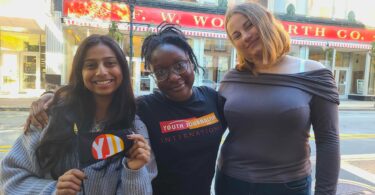Copenhagen, DENMARK – Sixty years ago, Copenhagen was a vastly different place, and Annelise Pio, 74, is here to take us on a tour of a young Copenhagener in the ‘60s.
Listen to the author read this story:
Pio, an artist, grew up in a working-class family on the outskirts of Copenhagen. Her father took evening classes to build up his career working in an office.
Growing up, Pio went to all the museums in Copenhagen with her father and she grew to love them.
She continued into Gymnasium, which is the word for high school in Denmark. Pio said she was not pressured to do anything about studying, nor did her school hold expectations on her.

In comparison to today, she had only two main options: language or math.
In today’s Gymnasium, you have the choice of four types of Danish-speaking Gymnasium, which each have options within them. It is also more common now to take vocational education, and it is encouraged.
Pio chose to take language as that was what most girls took, but she loved math. She found joy in learning Latin, as it was structured like Math.
Her class was forbidden to hold parties due to past events, she said. Previously, students would have “exciting parties” where beer would be passed through windows.
Pio described the older class as being “wild” and the younger class as mainly “hippies.” She believed she was in the “dull class.”

The theater was a place where she found joy, visiting six times a season with two boys from her school. She loved to hear the English language, which she learned at school, as well as Latin. Shakespeare was one of her favorites.
In her free time, she enjoyed reading and became obsessed with one author. She spent time with her friends drinking tea until the early hours of the morning.
Taking long walks in the woods and going to Copenhagen to see a movie were other activities she participated in. She listened to music and bought music to play on the gramophone.
Pio also danced in Latin and ‘standard’ dance competitions at what was called Folket Huset in Vesterbro, translated to the people’s house, owned by a workers’ union. This venue is now known as Vega. This was the place where her parents met, and now her grandchildren watch performances there.
She recognizes that the facility remains the same, but the contents change, and she said she likes that.
She visited the same union building for her father’s union Christmas party, where each child received an age-appropriate gift hand-chosen for them.
Today, many people will spend time at home watching Netflix or hanging out in the city center.
Pio explained that people did not drink as much at parties then as they do today. They would sing together – mainly protest songs that came from both America and Denmark, including “Blowing in the Wind” and “House of the Rising Sun.”
She took a trip to England to practice her English around her 18th birthday in 1968, when huge festivals and rock music were popular. She said they were warned to be careful of the English boys as there was “funny stuff” around, such as marijuana.

In the late ‘60s, when she wanted to start at university, things started to get difficult, Pio said.
According to Pio, there were revolts in the universities, putting students in control of decisions. Some institutions became “flower power” and others were mostly interested in Socialist ideology – this didn’t appeal to Pio. She wanted to study architecture and was given two options.
The first option was town scaping, which was mainly reading material with what Pio refers to as a “very left-wing town scaping.”
The second option was a house building line, which is what Pio took. She did not enjoy it and switched to history. She loved history and never looked back.
From Pio’s point of view, Denmark is weaker and more unsafe than in the ‘60s. She felt concerned about nuclear reactors in the ‘60s and the crisis preparation now.
She felt safer on the streets in the ‘60s, though.
When she was growing up, she was forbidden to go to Freetown Christiania, an independent commune in Copenhagen which was known for the selling of marijuana until late last year. She went to Christiania anyway and Vesterbro, which until the last decade has been a dangerous area with a lot of hard drug abuse.
According to Pio, most young people believed in left-wing ideology and voted Social Democrat.

Looking back, Pio wished they had computers. When she did her work at university, she had to use a typewriter.
But she was quite happy that she didn’t have social media growing up.
Pio’s vivid memory of the time when she was growing up shows some big changes as well as things that have remained the same.
Noah Haynes is a Senior Reporter with Youth Journalism International.



